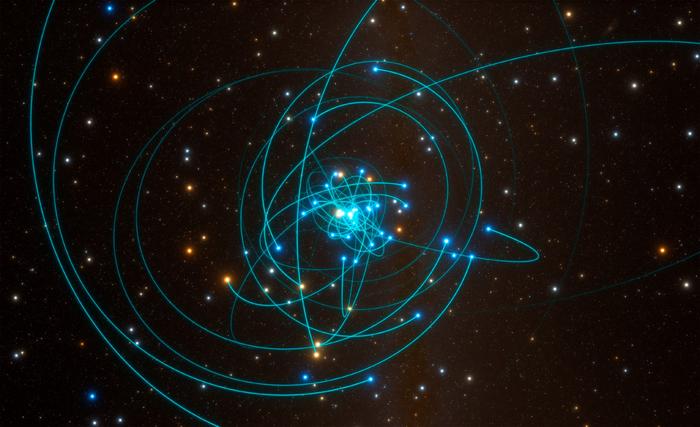In the center of our Milky Way galaxy, some strange things are happening with the stars. Despite being incredibly old, some stars orbiting around the supermassive black hole look deceptively young and fresh. But unlike humans who get anti-aging treatments, these stars stay looking youthful for a much darker reason – they are eating their neighbor stars!
This peculiar finding comes from new research done at Northwestern University. The scientists used a new computer model to track the violent paths of 1,000 simulated stars circling the huge black hole at the galaxy’s center, called Sagittarius A* (Sgr A*).
The area around the black hole is extremely crowded with stars moving at extreme speeds. “It’s a bit like running through an incredibly crowded subway station in New York City during rush hour. If you aren’t colliding into other people, then you are passing very closely by them,” explained Northwestern’s Sanaea C. Rose, who led the study.
With so many stars packed densely together and moving so fast, stellar collisions frequently occur in this region. By simulating these intense collisions, the researchers found two main outcomes – some stars lose mass and become stripped down lightweight stars, while others merge together to become super massive and appear rejuvenated.
“For stars, these near collisions still cause them to interact gravitationally. We wanted to explore what these collisions and interactions mean for the stellar population and characterize their outcomes,” said Rose.
The black hole’s immense gravitational pull accelerates the orbiting stars to whip around at terrifying speeds up to thousands of kilometers per second. Within just 0.1 parsecs of the black hole – a tiny distance equal to about 200 times the distance from the Earth to the Sun – hardly any stars escape some sort of collision or grazing impact.
“The closest star to our sun is about four light-years away,” Rose explained. “Within that same distance near the supermassive black hole, there are more than a million stars. It’s an incredibly crowded neighborhood.”
The simulations showed that very close to the black hole, within 0.01 parsecs, the stars move so fast that when they collide it’s more like a “violent high five” as Rose describes it. The impacts shed the stars’ outer layers but aren’t powerful enough to totally destroy them, creating a population of strange, stripped-down lightweight stars.
Further out from 0.01 parsecs, the slower-moving stars completely merge together when they collide instead of just grazing. “A few stars win the collision lottery,” said Rose. “Through collisions and mergers, these stars collect more hydrogen. Although they were formed from an older population, they masquerade as rejuvenated, young-looking stars. They are like zombie stars; they eat their neighbors.”
However, this youthful reboot comes at a cost. “They die very quickly,” Rose said. “Massive stars are sort of like giant, gas-guzzling cars. They start with a lot of hydrogen, but they burn through it very, very fast.”
Rose finds studying this bizarre, extreme environment deeply fascinating. “It’s an environment unlike any other. Stars, which are under the influence of a supermassive black hole in a very crowded region, are unlike anything we will ever see in our own solar neighborhood.”
By learning about these unique stellar populations, Rose hopes to uncover clues about the history and assembly of the Milky Way’s center, an area extremely difficult to directly observe. “At the very least, it certainly provides a point of contrast for the neighborhood where we live.”
The research, supported by NASA, NSF and other fellowships, was published in astrophysics journals in 2023 and 2024. Rose presented the findings at the American Physical Society meeting in April 2024.


